Soy Sauce
Introduction
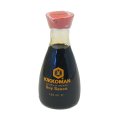 Soy sauce is a condiment that features in the cupboards of kitchens all over the Far East. It’s used as an at-table condiment or in stir-fries, as a dipping sauce or in marinades and dressings. It can come in many guises: thick, thin, dark, light. With all these different types, how does one understand what the difference between them is and more importantly decide which ones to use?
Soy sauce is a condiment that features in the cupboards of kitchens all over the Far East. It’s used as an at-table condiment or in stir-fries, as a dipping sauce or in marinades and dressings. It can come in many guises: thick, thin, dark, light. With all these different types, how does one understand what the difference between them is and more importantly decide which ones to use?
This article aims to provide an introduction to some of the more common soy sauces and highlight differences and provide tips on usage.
History
Soy sauce dates back over 2,500 years when it was used as a condiment in China. Early incarnations of this delicious sauce resembled a salty soybean paste. Several centuries later soy sauce was introduced into Japan where it became known as Shoyu.
Soy sauce is made by fermenting soy beans with water, salt and some yeast or koji (a mash containing a naturally occuring mould) for several months. The resulting mixture is then strained and bottled. Modern soy sauces generally also include roasted grain such as wheat as an ingredient to give the sauce a lighter flavour. Most soy sauces have a salty, earthy flavour and should exhibit a basic savoury flavour called ‘Umami’, which comes from the natural glutamates that are created by the fermentation process. Other natural sources of this Umami flavour are Kombu (Kelp), Bonito, Shiitake Mushrooms and even Beef, Ripe Tomatoes and Parmesan Cheese!
Modern science has meant that cheaper varieties of soy sauce have become available which have been artificially fermented using chemicals. The flavour of these is generally agreed to be less developed than naturally fermented soy sauces. Where possible, it is always worth spending a little more on naturally brewed soy sauce.
Whilst soy sauce features in many different cuisines the saltiness, fragrance, colour and viscosity can vary greatly so as tempting as it may be, it is often not appropriate to substitute soy sauces across cuisines.
Chinese Soy Sauce
Chinese soy sauce generally falls into one of two categories – fresh (called sang chau in Cantonese) and old (lou chau), also known as ‘light’ and ‘dark’ soy sauces, respectively. The main difference between the two types of soy sauce is the length of time for which it is fermented.
Light Soy Sauce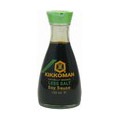
Also known as ‘thin soy’, this soy sauce is light in colour and is used for flavouring dishes. The addition of wheat to the fermentation process lends the sauce a lighter colour and taste. Light soy sauce is perfect for marinating meats and adding to stir fries instead of salt.
If you are watching your salt intake, low sodium versions of light soy sauce also exist and may be used in place of ordinary light soy sauce.
Why not try adding some slices of fresh chilli to a few tablespoons of light soy sauce and a few drops of sesame oil as a perfectly spicy-salty dip for dumplings and meat?
Dark Soy
Dark soy sauce has been left to ferment for longer, giving it a more mellow and rich flavour and brownish-black colour. Dark soy sauce is less salty and is used as much to impart a delightful colour to dishes as it is to flavour them.
To tell whether the bottle you have picked up contains light soy or dark soy, tilt the bottle so that the soy covers the clear part of the glass and straighten up again. With light soy, the glass will clear quite quickly, whilst dark soy will leave a more obvious tide mark.
Adding dark soy sauce to a marinade gives food a great caramel colour, like in this recipe for Sticky Oriental Soy Chicken Wings.
Other Chinese Soy Sauces
There are many other varieties of soy sauce available in chinese cooking:
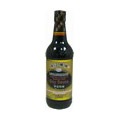 Mushroom Soy – This is a dark soy sauce flavoured with mushroom extract. Used in the same way as dark soy sauce, it has a delicious aroma of mushroom.
Mushroom Soy – This is a dark soy sauce flavoured with mushroom extract. Used in the same way as dark soy sauce, it has a delicious aroma of mushroom.- Thick Soy Sauce – This is a sweet dark soy sauce that has been thickened with molasses and starch. It is also known as soy jam and it comes in a jar as it is too thick to pour. Stir in a small half-teaspoon to fried rice at the last minute to add colour and a hint of sweetness or use sparingly in marinades for meat.
- Chilli Soy Sauce – Some soy sauces come ready-infused with a chilli kick for convenience, and may be used in the same way as one might use a light soy sauce.
Japanese Soy Sauce
Shoyu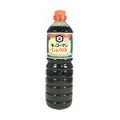
Shoyu is a Japanese style light soy sauce that is made in the same way as Chinese light soy. Japanese soy sauces tend to have a slightly saltier and cleaner taste than Chinese sauces and are used both in cooking and for dipping.
Tamari
Tamari is a traditional-style soy sauce that is made using very little or no wheat, making it suitable for coeliacs and those with gluten allergies.
Other Oriental Soy Sauces
- Kecap Asin – (Ketjap Asin, Kicap Cair is a similar sauce used in Malaysia) This is a salty, thick soy sauce that originates from Indonesia. It is made and used in a similar fashion as Chinese soy sauce, but has a stronger flavour.
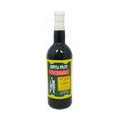
- Kecap Manis – (Ketjap Manis, Kicap Lemak is the Malaysian equivalent) This sweet soy sauce is darkened using molasses and is commmon to Indonesian and Malaysian cusine.
- Toyomansi – This soy sauce has been flavoured with Calamansi (a citrus fruit common to the Far East) and is a popular condiment in cuisine from the Philippines.
